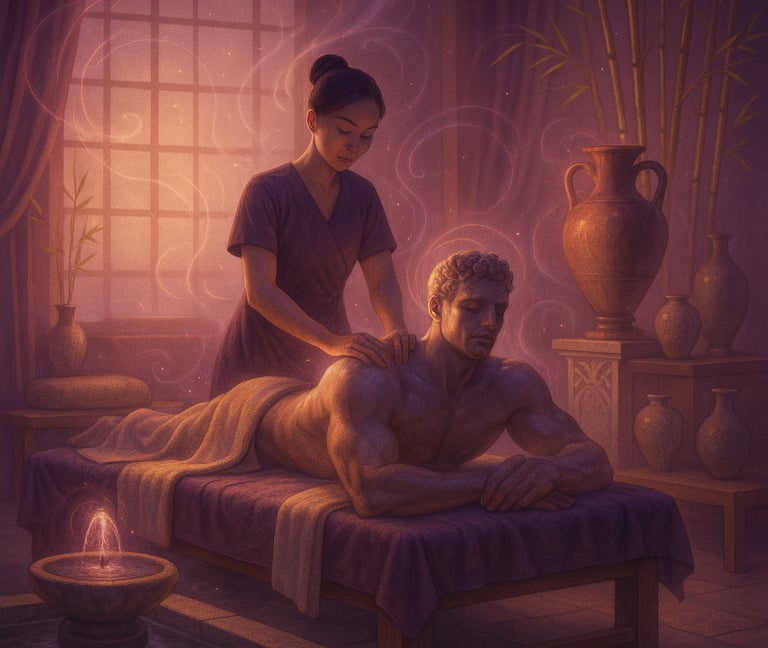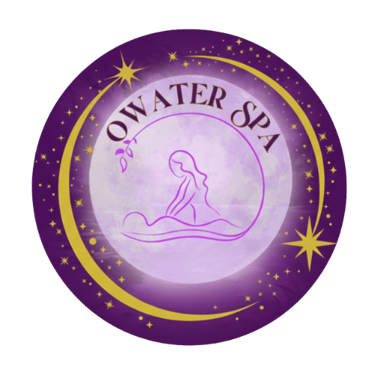Ancient Warrior Healing
From Battlefield to Spa Table - The Evolution of Massage Therapy
D Owater
6/4/20256 min read


The Ancient Warrior Healing: From Battlefield to Spa Table - The Evolution of Massage Therapy
The pursuit of well-being is a timeless human endeavor, and in our modern age, massage therapy stands as a testament to this enduring quest. But what many don't know is that the soothing techniques we enjoy today have a rich and storied past, deeply intertwined with the healing practices of warriors. From the battle-scarred veterans of ancient Greece to the legendary samurai of Japan, massage has been a vital component of recovery and resilience. Let's embark on a journey to explore the captivating evolution of these ancient traditions, tracing their path to the full body massage and relaxation techniques that define the modern Asian spa experience.
The Ancient Warrior's Medicine: Battlefield Recovery Techniques
Ancient civilizations recognized the critical importance of massage in the rehabilitation of their warriors. In Homer's epic poem, the Iliad (circa 762 BCE), there is a specific mention of massage with aromatic oils being used "as a means to relax the weary limbs of warriors and aid wound healing." These treatments were far from mere luxuries; they were essential medical interventions designed to keep their fighting forces in optimal condition.
Warriors faced a unique set of physical and mental challenges that necessitated specialized recovery methods:
Muscle Fatigue: The constant strain of carrying heavy armor and weaponry led to severe muscle fatigue and exhaustion.
Battle Wounds: Warriors frequently sustained injuries that required accelerated healing to ensure their swift return to combat.
Stress and Trauma: The psychological toll of warfare left warriors burdened with stress and trauma, impacting both their physical and mental well-being.
Rapid Recovery: The need for rapid recovery was paramount, as warriors had to be ready to return to battle at a moment's notice.
Eastern Traditions: The Foundation of Modern Asian Massage
The healing traditions of the East played a pivotal role in shaping the massage techniques we know today. Let's explore some of the key practices that have influenced modern Asian massage:
Chinese Warrior Recovery (Tuina)
Dating back over 2,000 years, Chinese Tuina massage was specifically developed to treat injuries and restore energy to warriors. This ancient technique is based on the principles of Traditional Chinese Medicine (TCM) and follows acupuncture principles without the use of needles. Tuina focuses on stimulating meridians, or energy channels, to promote healing and restore balance within the body.
According to massage expert Marisa, "Tuina is more than 2000 years old, and the massage is based on the principles of ancient Chinese medicine. In this technique, pressure points on your body are massaged and stimulated to relieve you from pain and stress."
Tuina techniques encompass a wide range of manual therapies, including:
Rowing Movements: These rhythmic movements are used to increase circulation and warm up the muscles.
Finger and Thumb Manipulation: Skilled practitioners use their fingers and thumbs to apply pressure to specific acupoints along the meridians, stimulating energy flow and promoting healing.
Circular Kneading: This technique involves kneading the muscles in a circular motion to release tension and improve circulation.
Squeezing: Squeezing is used to target tight areas, particularly in the neck and shoulders, to relieve muscle knots and tension.
Rocking: Rocking movements are applied with the palm to boost circulation and soften the body tissues.
Japanese Warrior Healing (Shiatsu)
Samurai warriors, renowned for their discipline and martial prowess, relied on specialized massage techniques to maintain peak physical condition. These techniques eventually evolved into modern Shiatsu, a form of Japanese bodywork that utilizes rhythmic finger pressure on acupressure points to restore energy balance and improve overall well-being.
Shiatsu is based on the concept of "Ki," or vital energy, which flows through specific pathways in the body. By applying pressure to these points, Shiatsu practitioners aim to release blockages and promote the smooth flow of energy, leading to improved health and vitality.
Thai Massage: The Warrior's Restoration
Thai massage, also known as Thai yoga massage, is a unique and dynamic form of bodywork that combines Indian and Chinese influences. Historically, Thai massage was used to help warriors recover from the rigors of battle, restoring their flexibility, energy, and mental clarity.
As Marisa notes, "Traditional Thai massage was initially created as a combination of Indian and Chinese massage, and it was introduced in Thailand by Buddhist monks years ago."
Thai massage techniques include:
Assisted Yoga Postures: The practitioner guides the recipient through a series of yoga-like stretches to increase flexibility and range of motion.
Pressure Point Therapy: Pressure is applied to specific points along the body's energy lines to release tension and promote healing.
Energy Line Work: The practitioner works along the body's energy lines, or "Sen," to stimulate energy flow and restore balance.
Full Body Stretching: Full body stretching is used to improve mobility and release muscle tension.
Modern Applications: From Battlefield to Spa
Today, the benefits of massage therapy extend far beyond the battlefield. Modern athletes, often considered the warriors of our time, continue to rely on massage to enhance their performance, recover from injuries, and maintain optimal physical condition.
Research has consistently demonstrated that massage techniques can:
Reduce Muscle Soreness and Speed Recovery: Massage helps to alleviate muscle soreness and stiffness following intense physical activity, promoting faster recovery.
Improve Flexibility and Range of Motion: Regular massage can increase flexibility and range of motion, enhancing athletic performance and reducing the risk of injury.
Boost Circulation and Oxygen Delivery: Massage stimulates blood flow, delivering oxygen and nutrients to the muscles and tissues, which is essential for optimal function and recovery.
Support Injury Prevention and Healing: Massage can help to prevent injuries by addressing muscle imbalances and promoting tissue health. It also supports the healing process following injuries, reducing pain and inflammation.
Enhance Focus and Reduce Performance Anxiety: Massage has been shown to reduce stress and anxiety, promoting mental clarity and focus, which are crucial for athletic performance.
The Full Body Asian Massage Experience Today
Modern Asian full body massage seamlessly blends the ancient healing wisdom of warrior traditions with contemporary relaxation techniques. These massages are designed to provide a holistic experience, addressing both the physical and mental needs of the individual.
According to Vegas Top Massage, "Asian full-body massage is beneficial because it relieves pain, improves relaxation, and revitalizes the body by focusing on specific muscle groups and pressure points."
Key benefits of modern Asian full body massage include:
Enhanced Circulation: "An Asian full-body massage stimulates blood circulation in the body and is one of the most significant advantages obtained from it. Massage actually improves your circulation, which helps deliver oxygen and nutrients to the cells a bit more efficiently."
Stress and Anxiety Reduction: "Reducing stress and anxiety, such as the full-body massage included in Asian relaxation techniques, is another essential advantage. Its gentle pressure and repetitive action can relax the nervous system, making it stress-reducing."
Muscle Relaxation and Pain Relief: Just as ancient warriors found relief from battle strains, modern clients experience "muscle growth, etc. Relatively speaking, this can greatly reduce your pain and make it much easier for you to move around."
Improved Sleep Quality: "A full-body massage is an Asian spa house and relaxation technique that also promotes better sleep. Many try to fall asleep or practice bad sleep due to stress and anxiety. All of them have a calming effect and can increase your body's levels of the hormone that promotes sleep."
Choosing Your Warrior's Recovery
When selecting an Asian massage technique, it's important to consider your individual needs and preferences. Just as ancient warriors understood the importance of choosing the right tool for the job, you can select a massage style that best suits your specific requirements:
Abhyanga (Indian): This Ayurvedic massage is best for overall maintenance and hydration, utilizing warm herbal oils to nourish the skin and promote relaxation.
Tuina (Chinese): Tuina is an excellent choice for pain relief and treating specific injuries, as it targets acupoints and meridians to restore balance and promote healing.
Thai Massage: Thai massage is perfect for improving flexibility and energy flow, combining assisted yoga postures with pressure point therapy to release tension and restore vitality.
As Marisa wisely advises, "My suggestion is that you shouldn't wait until you need a massage. Take care of yourself and benefit from the massages to maintain your good health and longevity."
Conclusion: The Timeless Healing Art
From the ancient battlefields to the serene spa tables of today, massage therapy has undergone a remarkable evolution while maintaining its core purpose: healing the body and restoring balance. The next time you indulge in a full body massage at an Asian massage spa, remember that you are participating in a therapeutic tradition that once helped warriors return to battle, now adapted to help you face the challenges of modern life.
Whether you're recovering from a strenuous workout, managing the stresses of daily life, or simply seeking relaxation and rejuvenation, these ancient techniques offer timeless benefits. As the warriors of old discovered, regular massage is not a luxury but an essential practice for maintaining peak physical and mental condition in a demanding world.
